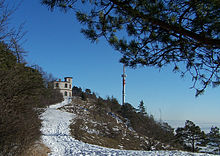Hörselberghaus
The Hörselberghaus is a building that was originally built as a clubhouse, shelter and inn on the Großer Hörselberg between 1889 and 1890 in the Thuringian Forest.
history
The establishment of the Thuringian Forest Association in 1880 was the reason for the establishment of similar associations in all regions of today's Free State in Thuringia. Thanks to the existing railway line, the Hörselberge have become one of the most popular destinations for summer visitors from Eisenach and Gotha.
Residents from the surrounding communities saw an additional source of income in the procurement of soft drinks and food for hikers and club groups. At first this wish failed because of the estimated construction costs. A committee founded in Gotha in 1886 to build a shelter on the Hörselberg persisted and used every opportunity to collect donations and building materials. As early as 1888, the grounds were acquired by the Gotha branch of the Thuringian Forest Association for 200 Reichsmarks from the Hastrungsfeld community .
On May 12, 1887, the “foundation stone” for a log house was laid, and the shell could be inaugurated on Ascension Day that same year. The temporary building was in no way able to cope with the following onslaught and encouraged the board of the association to build the massive Hörselberghaus. In addition to the 325 Gotha club members, the 385 Eisenach club comrades also took part in the fundraising. On September 22nd, the shell was finished and was celebrated with a topping-out ceremony . At the end of the construction work, construction costs amounted to 12,844 Reichsmarks. From 1890, after the opening, the inn and shelter was leased to the Hastrungsfelder innkeeper Ernst Meier. This was very popular and hosted guests for 30 years.
Plans to build a cable car or cogwheel railway did not materialize because of the high costs. From Kälberfeld, a path into the southern slope of the Großer Hörselberg was cut with great difficulty; it is the shortest but also the steepest path to the summit. After the discovery of the Thannhäuser cave , a local museum was considered, but even these plans came to nothing.
The building was spared during the Second World War and was subsequently confiscated by the Soviet occupying forces. As early as 1951 the business was resumed as an inn. In the course of the construction of a transmitter mast in 1975, an electrical power line was laid to the building. After German reunification , the Hörselberghaus was further expanded and renovated. It is used again as a restaurant and clubhouse.
Web links
Individual evidence
- ↑ a b c Christina Reissig: 120 years Hörselberghaus . In: Hörselbergverein (Ed.): Hörselbergbote . No. 81.Wutha-Farnroda 2010, p. 30-33 .
- ↑ http://www.thueringer-allgemeine.de/startseite/detail/-/specific/Hoerselberghaus-voraussichtlich-bis-Fruehling-ohne-Wirt-382014766
Coordinates: 50 ° 57 ′ 13.4 ″ N , 10 ° 27 ′ 40 ″ E
